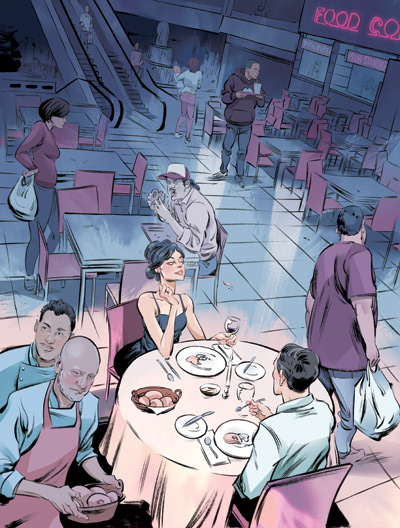Can Wild Boar Save the Suburban Mall?
THERE’S NO DOUBT ABOUT IT—THIS IS MARC VETRI’S OSTERIA. It’s 8 p.m. on a Saturday night, with a 45-minute wait and good-looking people standing three-deep at the bar. Ever-present beverage director Steve Wildy hustles in his ever-present dark gray suit, uncorking the second $75-plus bottle of red for two beefy guys who loom over a Lombarda pizza, which Food & Wine deemed the restaurant’s “signature” pie. Chef and partner Brad Spence, his whites strangely clean, surveys the dining room, which is tight and loud and thick with the aromas of braised rabbit and dry-aged rib eye and that magical wild boar bolognese. It’s exactly what we expect Osteria to be.
Except for one little hitch—the giant blue neon sign shining in through the front windows: SEARS.
Because here’s the thing: We’re not on North Broad.
We’re in a mall.
And not the swanky King of Prussia mall, or even the newly Nordstrom-ed Cherry Hill Mall.
We’re in the Moorestown Mall.
A mall? This is where Vetri decided to erect the second coming of Osteria, a restaurant that Newsweek called one of the 101 best in the world? Waaaay out on Route 38 in South Jersey? Facing a Sears? Staring right into a PacSun? Kitty-corner to a Spencer’s, with its sizeable selection of rainbow penis lollipops?
This would make sense … in 1986. That’s when the Moorestown Mall was totally bitchin’, packed with Gen X-ers scamming at the food court and Medford Wives browsing at Wanamaker’s, while everyone still marveled at the pretty fountain and the stream that ran right down the center of it all. This mall—and all malls, really—was a place to meet up and socialize, to be and be seen, like a Rittenhouse Square in the suburbs. Except with a consistent temperature of 75 degrees. And a Piercing Pagoda.
Not anymore. As one former mall chick in Riverton opines, “The Moorestown Mall is super depressing.” In February, on Moores-town Mall’s online directory, at least 25 out of about 100 stores appeared to be vacant. Just three years ago, the township’s Economic Development Advisory Committee worried that the mall—Moorestown’s biggest taxpayer—was foundering. On the same evening we dined at Osteria, parents were having a birthday scavenger hunt for their daughter in the mall, because they knew “no one would be there.” In fact, at any given time, on any given day, there are so few people inside that we half expect to walk into Kay Jewelers and be instantly consumed by zombies.
“Apocalyptic.” That’s how the current state of the American mall was recently described by Bloomberg TV. And the bad press only gets worse from there: “extinct,” “sick,” “dying” or, more to the point, “dead.”
“It has outlived its usefulness,” announced Rick Caruso, CEO of one of the country’s largest privately held real estate companies, Caruso Affiliated, in his keynote address at the National Retail Federation’s annual convention in January. There are all kinds of reasons for the decline: online shopping, fewer chains leasing space, fewer people living near malls. Caruso—who, it must be noted, owns malls—predicts that without a mass reinvention, enclosed malls as we knew and loved them will go the way of lickable stamps and Blockbusters in, at most, 15 years.
Even here, in the fifth largest retail market in the country, Moorestown is only one of many malls gasping. The Granite Run Mall in Media and the Coventry Mall in Pottstown were so empty and languishing in such debt that they were auctioned off last September. The Gallery at Market East, the old Cedarbrook Mall on Cheltenham Avenue and South Jersey’s Echelon Mall have all earned prominent (and justified) mentions on the nostalgic website Deadmalls.com.
Most telling, the Gen X-ers who grew up in malls, who now have the income to spend in malls, aren’t really psyched to shop in them anymore. When I asked some former mall rats, their evaluations were plain: Franklin Mills in the Northeast is “scary”; the Neshaminy Mall in Bensalem is “sad”; Exton Square is “a goth fest”; the Oxford Valley Mall in Langhorne is, simply, “shit.”
It’s no wonder, then, that when Marc Vetri announced he was opening at the Moorestown Mall, his fellow Philly restaurateurs asked him the same question, again and again:
“Are you nuts?”



